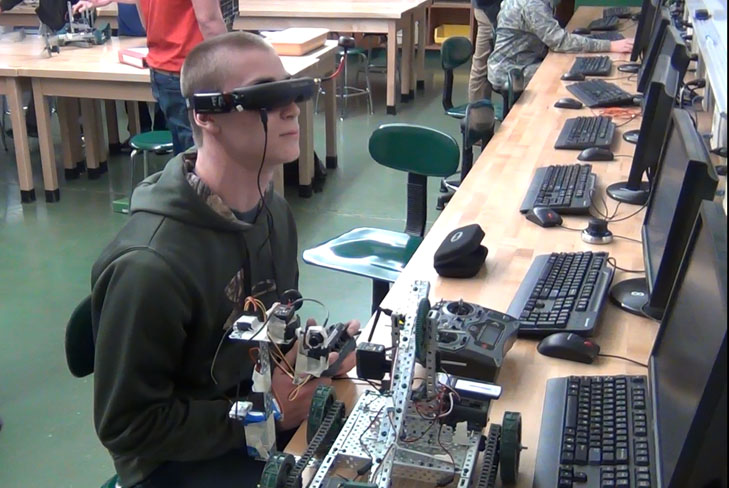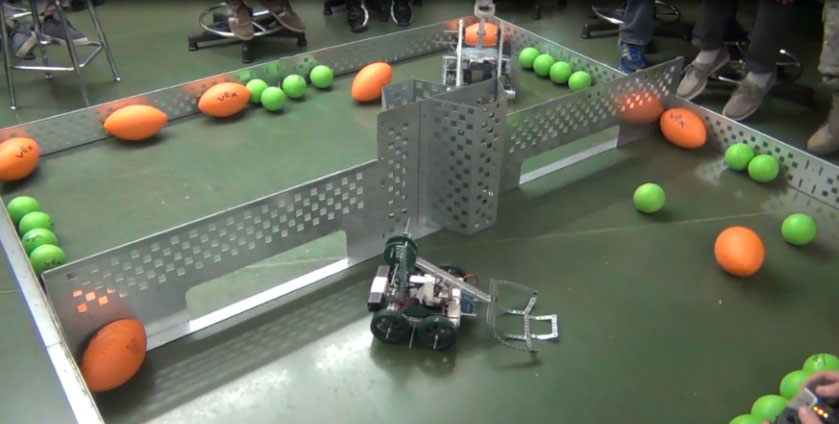Robotics Engineering
Requirements
Credit Value: 1.0
Term(s) Offered: Full Year
Prerequisite(s): None
Open to Grades: 10,11, 12
About Robotics Engineering
Robotics Engineering integrates mechanical, electrical, and software engineering. In this highly technical course, students design robots and robotic systems with an emphasis on engineering as well as project management. Throughout this course, students use a team approach to problem-solve large projects just as professional engineers do. Students learn the importance of mechanical design for manipulators and mobile robots, as well as pneumatic systems, including physics of fluid power and types of actuators. Electronics, including proper wiring solutions for motors and sensors, as well as control systems using both remote control and computer programming are incorporated into this course. Students use Robot C software to program their robots and Autodesk Inventor 3D modeling software to devise prototypes to be created on the 3D printer. Robotic sensors and their programming are also among the skills learned in this challenging course.
Course Goals/Objectives
An engineering discipline that is on the rise, robotics engineering is a breeding ground for creativity and innovation from people with a background in mechanical, electrical, or software engineering. Robotics engineers may work in the agricultural, military, medical, and manufacturing industries, among others, conceiving of new uses for robots, designing improved robots for existing systems, or repairing and maintaining industrial robots. ~ Princeton Review
Students who are looking to pursue a degree in the follow areas should seriously consider taking this course: Mechanical Engineering, Robotics Engineering, Manufacturing Engineering, Health & Safety Engineering, Electrical Engineering, Software Engineering, and Industrial Engineering.
Course Outline:
Unit 1 Introduction to Robotics
Lesson 1.1: History and Safety of Robotics
Lesson 1.2: Power and Drive Systems
Lesson 1.3: Robot Classifications
Unit 2 Power and Energy
Lesson 2.1 Types of Energy Sources
Unit 3 Project Management
Lesson 3.1: Team Building & Project Planning
Lesson 3.2: Understanding the Problem
Unit 4 VEX Robotic System
Lesson 4.1: Introduction to VEX
Lesson 4.2: Robotic Motion
Unit 5 Introduction to 3D Engineering and Design
Lesson 5.1: Autodesk Inventor
Lesson 5.2: Rapid Prototyping Parts
Unit 6 Fluid Power
Lesson 6.1: Pneumatic and Hydraulic
Lesson 6.2: Physics of Fluid Power
Unit 7 Introduction to Robotic Programming
Lesson 7.1: Planning and Behaviors
Lesson 7.2: Pseudocode & Flowcharts
Lesson 7.3: Understanding Natural Language
Unit 8 Sensors
Lesson 8.1: Types of Sensors and Applications
Lesson 8.2: Sensor Usage
This course is currently taught by Mr.Clark.
Robotics Engineering & Video
Robotics Pictures



